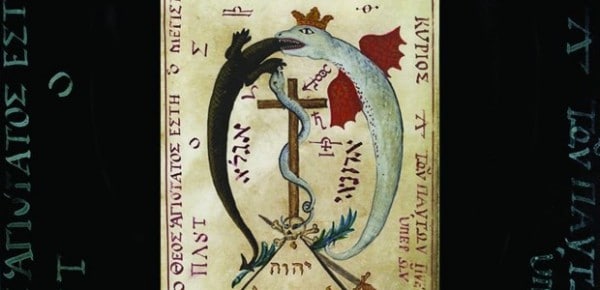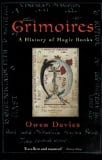
 Grimoires: A History of Magic Books, by Owen Davies
Grimoires: A History of Magic Books, by Owen Davies
Oxford University Press, 978-0-19-959004-9, 380 pp., 2009
I need to acknowledge right now that I am not a ceremonial magician, but then again, this book is written for people like me. This is not a compilation of grimoires, nor is it a distillation of those books. It is a broad overview of magick books and books about magick (which are not necessarily the same thing). There is a fairly thorough discussion of the suppression of magick books, which makes it abundantly clear that, although most of us think in terms of the Christian church’s efforts in this respect, Christianity was a “Johnny come lately” to that game. There had been suppressions long before the beginning of the Common Era.
This type of book often falls into one of two categories. It is either heavily influenced by pop culture, or it is full of erudite, academic attitudes which leave you grabbing your dictionary as you read. This book walks the middle ground quite nicely. It answers questions with easily understood words, and saves the inevitable citations for the end of the book.
One thing which modern readers often forget when reading about the grimoires of the past is that simply because two (or more) books had the same name did not mean they had they same content, especially in a time when the books in circulation were manuscripts, as opposed to printed volumes. Religious scholars has this brought home to them with the discovery of the Nag Hammadi library where there were numerous books with identical names and widely varying contents. Grimoires were, generally, perceived as having more power if they were handwritten (magicians would make handwritten copies of books which they had in their library to impart more power to them). What this means is that even those grimoires which have survived in printed form may only be one version of numerous ones which circulated during the Renaissance and later periods.
Also, bearing in mind the expense of papyrus, parchment, or (eventually) paper, books tended to be relatively short. Thus, a “massive” grimoire might have consisted of 50 to 100 pages handwritten, with illustrations scattered throughout. Today, with the technology available by the middle of the 20th century, that could have translated into a printed booklet of 15 to 40 pages. Therefore a magician who had 50 books of magick in his library wouldn’t raise an eyebrow today, but in the past would have been seen as very knowledgeable (and probably quite wealthy).
Another thing which must be taken into account is that, with the generally low literacy rates of the past, there was a tendency to consider any book to be magical; thus astrological books, almanacs, prayer books, philosophical writings, and mathematical books could be, and often were, lumped in among those books which were considered to be grimoires. Most magical practitioners could not afford (or else could not read) the grimoires which circulated, and thus made do with diagrams copied from them, lists of names and words, or simply possession of the books themselves.
The author takes great pains to explore not only the “magick books” themselves, but the perceptions of those who possessed them; those who attempted to ban them; and the “average” individual of the time.
That is what makes this such a valuable resource. Modern readers tend to forget that things have evolved on many levels since the advent of civilization and, even more so, during the past few centuries.
How many of you reading this review are aware of the alleged magickal underpinnings of the Church of Jesus Christ of Latter Day Saints (the Mormon church)? How many know that several Popes of the Roman Catholic Church were accused of working magick? And were also cited as authors of popular grimoires? And that there were books of magic in the colonies in America (French, British, and Spanish)?
Of course, Davies doesn’t neglect the better-known aspects either. There are references to Theosophy, Rosicrucianism, the belief in antediluvian civilizations, and the pre-eminence of Egypt as a source of magical knowledge. The important thing about this book, from the standpoint of someone involved with modern magickal thought, is that it helps to clarify relationships of which the average individual is only moderately aware.
The most valuable section, to my mind, is the section which deals with the magic books which were published during the late 19th and early 20th century. People sometimes forget that some organizations (The Hermetic Order of the Golden Dawn comes to mind) produced their own magic manuals. Some of them were made available (intentionally or otherwise) to the wider public. In the early 20th century there were publishers who played fast and loose with the laws of copyright, and produced unauthorized editions of circulating books (often in languages other than the originals) at reduced prices, and in many cases inferior quality, and with altered authorship claims. Some of these books gained their own notoriety and went on to influence generations of magicians.
Although this book is not aimed at the Pagan or magical communities, it will serve those groups well, especially as it concludes its survey of grimoires with a look at three modern creations: The Necromonicon, the Book of Shadows, and The Satanic Bible. Each of these books was created to fill a perceived need; each was stitched together from existing sources (and contained spurious or missing attribution) and each has come to have its own devoted group of followers.
While I do not necessarily agree with all of the author’s conclusions and assertions, I am capable of understanding how they have been arrived at. He makes no attempt to peddle his own conclusions at the expense of alternative beliefs, he merely shows what has led him to his final position.
As many books were written to show the fallacy of the grimoires in circulation, and this book will undoubtedly find its way into the hands of individuals who will use it to give their bookshelves a look of authenticity. It will also be used by some individuals as a source of their own supposed magical ability, without a doubt. But these are secondary uses. The primary use is, and should be, to expand knowledge of the history of books of, and about, magick. As such, I highly recommend it.







